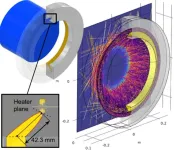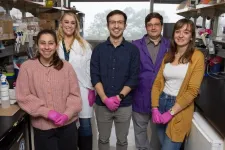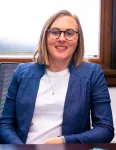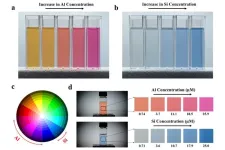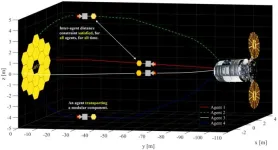(Press-News.org) RIVERSIDE, Calif. -- In a paper published earlier this month in Physical Review Letters, a team of physicists led by Jonathan Richardson of the University of California, Riverside, showcases how new optical technology can extend the detection range of gravitational-wave observatories such as the Laser Interferometer Gravitational-Wave Observatory, or LIGO, and pave the way for future observatories.
Since 2015, observatories like LIGO have opened a new window on the universe. Plans for future upgrades to the 4-kilometer LIGO detectors and the construction of a next-generation 40-kilometer observatory, Cosmic Explorer, aim to push the gravitational-wave detection horizon to the earliest times in the history of the universe, before the first stars formed. However, realizing these plans hinges on achieving laser power levels exceeding 1 megawatt, far beyond LIGO’s capabilities today.
The research paper reports a breakthrough that will enable gravitational-wave detectors to reach extreme laser powers. It presents a new low-noise, high-resolution adaptive optics approach that can correct the limiting distortions of LIGO’s main 40-kilogram mirrors which arise with increasing laser power due to heating.
Video.
Richardson, an assistant professor of physics and astronomy, explains the paper’s findings in the following Q&A:
What are gravitational waves?
Gravitational waves are a new way to observe the universe. They are predicted by the equations of general relativity. When massive objects accelerate or collide in the universe, distortions in the fabric of space-time propagate out like ripples in a pond at the speed of light. These distortions are gravitational waves and, like electromagnetic waves, they carry energy and momentum. We now have a lot of information about the extreme astrophysical objects like black holes that create them and about the physics of the underlying nature of spacetime that these waves travel through to reach us.
How does LIGO work?
LIGO is one of the largest pieces of scientific equipment in the world. It consists of two 4 kilometers by 4 kilometers-long laser interferometers. One of these interferometers is in inland Washington State; the other is outside Baton Rouge, Louisiana. These sister sites operate in tandem, passively listening to any distortions of spacetime that might happen to propagate through Earth as a gravitational wave.
LIGO so far has seen about 200 events of stellar mass compact objects colliding and merging with each other. The overwhelming majority have been mergers of two black holes, but we’ve also seen mergers of neutron stars. I hope we may one day detect some source that is completely unexpected and unpredicted. If you look at the history of astronomy, every time we’ve developed electromagnetic telescopes that can observe a different wavelength of light than has never been observed before, we see the universe literally in a new light and have almost always discovered new types of objects visible in that wavelength band but not in others. I hope the same is true for gravitational waves.
Tell us about the instrument you’ve developed in your lab that has LIGO applications.
My focus at UCR is on developing new types of laser adaptive optical technology to overcome very fundamental physics limitations to how sensitive we can make detectors like LIGO. Across the majority of gravitational wave signal frequencies we can see from the ground, almost all of them are limited in sensitivity by quantum mechanics, by the quantum properties of the laser light itself that we use in the interferometer to bounce off mirrors. The instrument we’ve developed in my lab is designed to deliver precision optical corrections directly to the main mirrors of the LIGO interferometers. Our instrument is designed to sit just centimeters in front of the reflective surface of these mirrors and project very low noise corrective infrared radiation onto the front surface of the mirror. It is the first prototype for a totally new type of approach that uses non-imaging optical principles, which has never been used in gravitational wave detection before.
What is Cosmic Explorer?
Cosmic Explorer is the U.S. concept for a next-generation gravitational-wave observatory, after LIGO. It will be 10 times the size of LIGO, so that’s 40 by 40-kilometer-long interferometer arms. It will be the largest scientific instrument ever built. At their design sensitivity, these detectors will see the universe at earlier times than when the first stars are believed to have formed, when the universe was about 0.1% of its present 14-billion-year age. We will be able to see a snapshot of the universe at a very early stage in time.
Briefly, what does the research paper discuss?
The paper demonstrates that high-precision optical corrections are essential to expanding our gravitational-wave view of the universe. It lays out the potential implications for the impact we expect our new technology to have in the next generation of LIGO and in the years beyond that. Importantly, the paper shows that this type of technology is necessary and adequate to enable much higher levels of circulating laser power in the LIGO detectors than ever before. We expect this technology, and future versions of it, will be able to achieve more power in the interferometer.
Why is it important to do this research?
This research promises to answer some of the deepest questions in physics and cosmology, such as how fast the universe is expanding and the true nature of black holes. There are two contradicting measures right now of the local expansion rate of the universe, which gravitational waves can potentially resolve. Gravitational waves will also provide exquisitely high precision measurements of the detailed dynamics around the event horizons of black holes, allowing us to make direct tests of classical general relativity and alternative theories.
The University of California, Riverside is a doctoral research university, a living laboratory for groundbreaking exploration of issues critical to Inland Southern California, the state and communities around the world. Reflecting California's diverse culture, UCR's enrollment is more than 26,000 students. The campus opened a medical school in 2013 and has reached the heart of the Coachella Valley by way of the UCR Palm Desert Center. The campus has an annual impact of more than $2.7 billion on the U.S. economy. To learn more, visit www.ucr.edu.
END
New technology enhances gravitational-wave detection
Instrument developed at UC Riverside will help answer fundamental questions in physics and cosmology
2025-02-14
ELSE PRESS RELEASES FROM THIS DATE:
Gene therapy for rare epilepsy shows promise in mice
2025-02-14
Dravet syndrome and other developmental epileptic encephalopathies are rare but devastating conditions that cause a host of symptoms in children, including seizures, intellectual disability, and even sudden death.
Most cases are caused by a genetic mutation; Dravet syndrome in particular is most often caused by variants in the sodium channel gene SCN1A.
Recent research from Michigan Medicine takes aim at another variant in SCN1B, which causes an even more severe form of DEE.
Mice without the SCN1B gene experience seizures and 100 percent mortality just ...
Scientists use distant sensor to monitor American Samoa earthquake swarm
2025-02-14
In late July to October 2022, residents of the Manu’a Islands in American Samoa felt the earth shake several times a day, raising concerns of an imminent volcanic eruption or tsunami.
An earthquake catalog for the area turned up nothing, because the islands lacked a seismic monitoring network that could measure the shaking and aid seismologists in their search for the source of the earthquake swarm.
But the residents of the Taʻū, Ofu, and Olosega islands needed answers, so Clara Yoon of the ...
New study explains how antidepressants can protect against infections and sepsis
2025-02-14
LA JOLLA (February 14, 2025)—Antidepressants like Prozac are commonly prescribed to treat mental health disorders, but new research suggests they could also protect against serious infections and life-threatening sepsis. Scientists at the Salk Institute have now uncovered how the drugs are able to regulate the immune system and defend against infectious disease—insights that could lead to a new generation of life-saving treatments and enhance global preparedness for future pandemics.
The Salk study follows recent findings that users of selective ...
Research reveals how Earth got its ice caps
2025-02-14
University of Leeds news
Embargoed until 14 February 2025 (19:00 GMT)
---
The cool conditions which have allowed ice caps to form on Earth are rare events in the planet’s history and require many complex processes working at once, according to new research.
A team of scientists led by the University of Leeds investigated why Earth has existed in what is known as a 'greenhouse' state without ice caps for much of its history, and why the conditions we are living in now are so rare.
They found ...
Does planetary evolution favor human-like life? Study ups odds we’re not alone
2025-02-14
UNIVERSITY PARK, Pa. — Humanity may not be extraordinary but rather the natural evolutionary outcome for our planet and likely others, according to a new model for how intelligent life developed on Earth.
The model, which upends the decades-old “hard steps” theory that intelligent life was an incredibly improbable event, suggests that maybe it wasn't all that hard or improbable. A team of researchers at Penn State, who led the work, said the new interpretation of humanity’s origin increases the probability ...
Clearing the way for faster and more cost-effective separations
2025-02-14
CLEVELAND—The process of separating useful molecules from mixtures of other substances accounts for 15% of the nation’s energy, emits 100 million tons of carbon dioxide and costs $4 billion annually.
Commercial manufacturers produce columns of porous materials to separate potential new drugs developed by the pharmaceutical industry, for example, and also for energy and chemical production, environmental science and making foods and beverages.
But in a new study, researchers at Case Western Reserve University have found these ...
Researchers develop a five-minute quality test for sustainable cement industry materials
2025-02-14
CHAMPAIGN, Ill. — A new test developed at the University of Illinois Urbana-Champaign can predict the performance of a new type of cementitious construction material in five minutes — a significant improvement over the current industry standard method, which takes seven or more days to complete. This development is poised to advance the use of next-generation resources called supplementary cementitious materials — or SCMs — by speeding up the quality-check process before leaving the production floor.
Due ...
Three Texas A&M professors elected to National Academy Of Engineering
2025-02-14
Drs. Vanderlei Bagnato, Rodney Bowersox and Don Lipkin from Texas A&M University’s College of Engineering have been elected to the National Academy of Engineering (NAE) Class of 2025, joining 128 new members and 22 international members. This is one of the highest professional honors for engineers.
“Congratulations to Drs. Bagnato, Bowersox and Lipkin for achieving this recognition. This prestigious honor reflects their groundbreaking contributions to engineering and underscores the exceptional talent within our faculty,” said Dr. Robert H. Bishop, vice chancellor and dean of Texas A&M ...
New research sheds light on using multiple CubeSats for in-space servicing and repair missions
2025-02-14
As more satellites, telescopes, and other spacecraft are built to be repairable, it will take reliable trajectories for service spacecraft to reach them safely. Researchers in the Department of Aerospace Engineering in The Grainger College of Engineering, University of Illinois Urbana-Champaign are developing a methodology that will allow multiple CubeSats to act as servicing agents to assemble or repair a space telescope. Their method minimizes fuel consumption, guarantees that servicing agents never come closer to each other ...
Research suggests comprehensive CT scans may help identify atherosclerosis among lung cancer patients
2025-02-14
Several cardiovascular risk factors, such as advanced age and smoking history, are prevalent among lung cancer patients at the time of the diagnosis and increase their risk of future heart disease, according to a new study being presented at ACC’s Advancing the Cardiovascular Care of the Oncology Patient course. Comprehensive assessments are needed in this vulnerable group to improve survival outcomes and quality of care for cancer patients.
Heart disease and cancer are the leading causes of death in the United States. Smoking is a shared risk factor for lung cancer and cardiovascular disease, and lung cancer patients have an amplified mortality rate with the presence of ...
LAST 30 PRESS RELEASES:
Making lighter work of calculating fluid and heat flow
Normalizing blood sugar can halve heart attack risk
Lowering blood sugar cuts heart attack risk in people with prediabetes
Study links genetic variants to risk of blinding eye disease in premature infants
Non-opioid ‘pain sponge’ therapy halts cartilage degeneration and relieves chronic pain
AI can pick up cultural values by mimicking how kids learn
China’s ecological redlines offer fast track to 30 x 30 global conservation goal
Invisible indoor threats: emerging household contaminants and their growing risks to human health
Adding antibody treatment to chemo boosts outcomes for children with rare cancer
Germline pathogenic variants among women without a history of breast cancer
Tanning beds triple melanoma risk, potentially causing broad DNA damage
Unique bond identified as key to viral infection speed
Indoor tanning makes youthful skin much older on a genetic level
Mouse model sheds new light on the causes and potential solutions to human GI problems linked to muscular dystrophy
The Journal of Nuclear Medicine ahead-of-print tip sheet: December 12, 2025
Smarter tools for peering into the microscopic world
Applications open for funding to conduct research in the Kinsey Institute archives
Global measure underestimates the severity of food insecurity
Child survivors of critical illness are missing out on timely follow up care
Risk-based vs annual breast cancer screening / the WISDOM randomized clinical trial
University of Toronto launches Electric Vehicle Innovation Ontario to accelerate advanced EV technologies and build Canada’s innovation advantage
Early relapse predicts poor outcomes in aggressive blood cancer
American College of Lifestyle Medicine applauds two CMS models aligned with lifestyle medicine practice and reimbursement
Clinical trial finds cannabis use not a barrier to quitting nicotine vaping
Supplemental nutrition assistance program policies and food insecurity
Switching immune cells to “night mode” could limit damage after a heart attack, study suggests
URI-based Global RIghts Project report spotlights continued troubling trends in worldwide inhumane treatment
Neutrophils are less aggressive at night, explaining why nighttime heart attacks cause less damage than daytime events
Menopausal hormone therapy may not pose breast cancer risk for women with BRCA mutations
Mobile health tool may improve quality of life for adolescent and young adult breast cancer survivors
[Press-News.org] New technology enhances gravitational-wave detectionInstrument developed at UC Riverside will help answer fundamental questions in physics and cosmology
